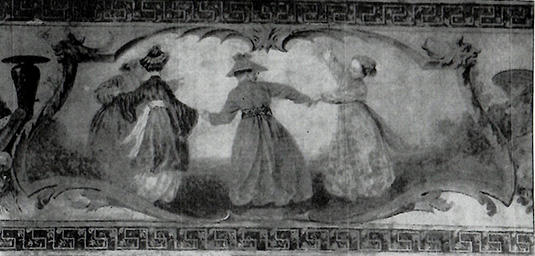
- Home Page
- Accepted
Paintings & Copies - Doubtful
Attributions - Doubtful Textual References
- Alternative
Titles - Collectors &
Museums - Bibliography
- Search Abecedario
- Watteau &
His Circle
X. Danse chinoise
Entered May 2023
Florence, Fondazione di studi storia dell’arte Roberto Longhi
Tempera on panel
26.5 x 149 cm
ALTERNATIVE TITLES
Chinoiserie
Cineseria
Couvercle de Clavecin à décor de Chinoiseries
PROVENANCE
Paris, collection of Daniel Saint (1778-1847; miniaturist). His sale, Paris, Hôtel des ventes, May 4-7, 1846, lot 66 bis: “DU MÊME [WATTEAU (Antoine)] . . . Divers sujets, pastorales, danses costumes, scènes chinoises; ces divers objets ont été peintes par Watteau, sur fond d’or, sur les panneaux d’un clavecin, provenant d’une maison royale.” According to an annotated copy of the sale catalogue in the Metropolitan Museum of Art, New York,, the lot sold for 1,051 francs to “Varneck.”
.
Paris, collection of Georges Edouard Warneck (1834-1924; art collector and dealer). His sale, Paris, Galerie Georges Petit, May 27-28, 1926, lot 93: “ÉCOLE FRANÇAISE vers 1750 . . . Couvercle de Clavecin à décor de Chinoiseries. Sur un fond d’or ceint d’une bordure de méandres, se détache, au milieu, un cartouche où est figurée une ronde gracieuse, dansée par quatre Chinois, deux hommes et deux jeunes filles. Leurs longs costumes aux tons rouges, bleus, violets, jaunes et rosés se détachent déliceusement sur un fond de ciel clair et de paysage. Des deux côtés de ce cartouche, des palmiers et des fruits, puis, à gauche, une femme jouant de la viole, aux son de laquelle danse un bambin et, à droite, un Chinois faisant danser un singe costumé. Bois. Haut., 26.5 cent.; larg., 1 m. 49 cent. M. Warneck attribuaît ce panneau et les suivants à Watteau et certainement le cartouche agrémenté de la ronde et donne une grâce tellement distinguée et d’une execution si délicate qu’il mérite cette attribution, à moins qu’un maître comme Ch. Huet n’ait égalé ici son illustre devancier. Voir la planche.”Paris, with Arthur Sambon (1867-1947; dealer).
Florence, collection of Roberto Longhi (1890-1970; art historian).
EXHIBITIONS
Albe, Fondazione Ferrera, Collezione di Roberto Longhi (2007), cat. 58 (as by Antoine Watteau and a collaborator, Cineseria).
SELECT BIBLIOGRAPHY
Goncourt, Catalogue raisonné (1875), under cat. 315.
Adhémar, Watteau (1950), under cat. 18, cat. 21 b.
Mathey, Watteau, peintures réapparues (1959), 42-44, 78.
Honour, Chinoiserie (1962), 88.
Macchia and Montagni, L’opera completa di Watteau (1968), cat. 29 D.
Boschetto, Collezione Roberto Longhi (1971), pl. 122.
Rosenberg, “Longhi e il Seicento francese” (1982), 210.
Improta, Passion por la pintura (1998), cat. 71.
REMARKS

Unidentified artis, Danse chinoise (detail).
This very long, narrow panel with its gold background was evidently a side panel on a harpsichord. But there are no grounds for presuming that it is by Watteau, much less that it was part of the décor in the château de la Muette as has been claimed by some.
Despite the assertions of Adhémar and Mathey, there is no documentation to link this panel from a harpsichord with La Muette. Indeed, it is quite different in its approach to a supposedly Eastern subject. The images at La Muette were Watteau’s interpretations based upon a travelogue about the Far East; they are more exacting in their depictions of the Far East. On the other hand, the figures in this panel, though they wear loose gowns in a free adaptation of Oriental garb, are only generalized restatements. Their dance à la ronde seems more at home in a French village fête. The decorative elements are uninspiring in comparison with Audran’s and Watteau’s inventive designs.
Today, Watteau scholars not only reject the attribution of this panel to Watteau, but eschew any mention of it. Only Adhémar, Mathey, and Macchia and Montagni have accepted it. Macchia and Montagni offered a shameful rationalization, claiming that the panel must be by Watteau because Roberto Longhi owned it, and his “critical insight . . . serves to guarantee the validity of attributing it to Watteau.” Yet even the most prestigious scholar is not infallible and, moreover, Longhi was a specialist of Italian, not French, art. The Longhi foundation has maintained the attribution to Watteau, although most recently it modified the classification to “Watteau and a collaborator.”
